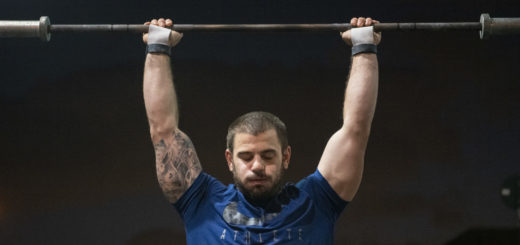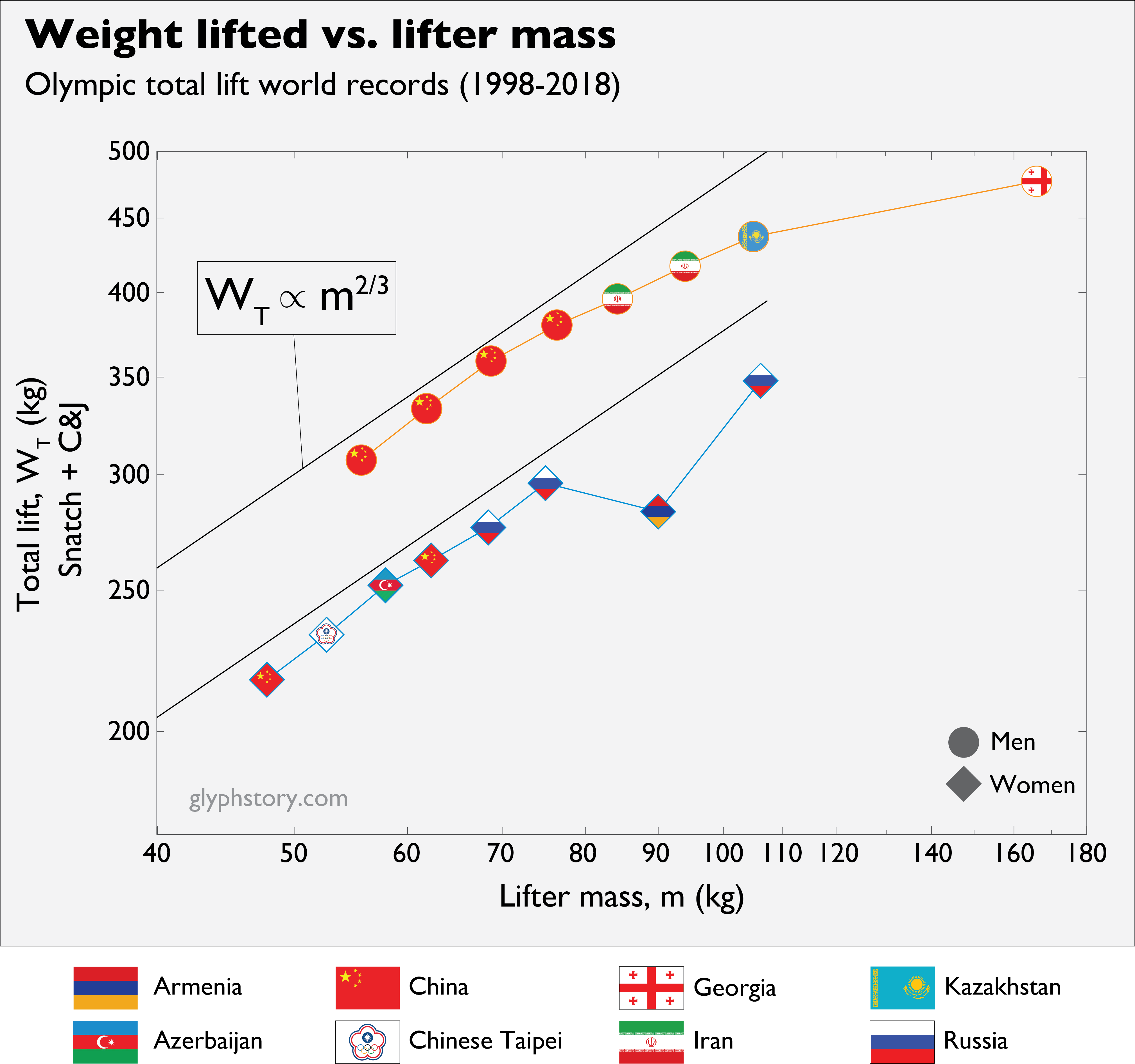Weightlifting GOATs
The super heavyweight class of weightlifters “…is comprised of the ones that seem to develop a psychological dependence on ingesting great amounts of food. They usually comment that they do not feel strong unless their bodyweight is high – i.e. over 140 kg. These individuals are quite corpulent, especially between the knees and nipples, and develop a slow, ponderous ‘superheavyweight gait’ – i.e. as their thighs rub in normal walking, they swing their legs slightly outward to reduce it.”
-RG Sinclair
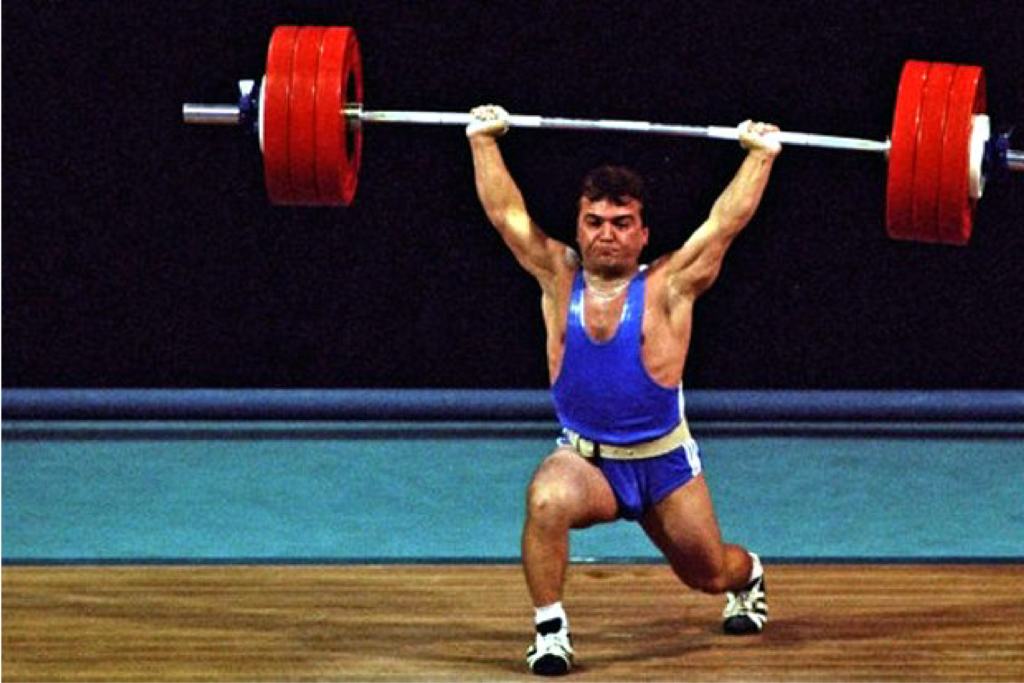
[Image credit: Shevked via Wikimedia Commons. Link to image. Link to license].
Greatest Of All Time discussions are always…interesting? They usually devolve into subjectivity after some cursory numbers are thrown around. Unless, of course, you’re in Boston, where “Brady’s the GOAT kid, regahdless of sport. Hands down. He’s got the numbahs. Next ahticle.” Yes, well, that’s good. And so are the Jordan vs. Lebron, Ruth vs. Mays and Tiger vs. Crippling Decision Making debates. As data-driven people, however, the argument in weightlifting is very compelling because performance is so easily quantified (pick things up and put things down), and furthermore, comparisons across weight classes are logically computed, as we’ll show. And for those who require a human interest component in their judgement of GOAT, fear not, weightlifting is absolutely rife with characters. There’s mammoth Leonid Taranenko and his still-record 586 pound clean & jerk set in 1988. Consider also multi-sport athlete Tara Nott, the first US woman to win Olympic Weightlifting Gold. Don’t forget super heavyweight and Elvis-Andre the Giant hybrid Vasily Alexeev. And we’d be remiss if we didn’t celebrate this guy, who’s just happy to be here…for a brief time anyway (please watch from 0:34 to 0:54).
Weigh these leviathans by your own criteria, but here’s how we’re deciding who’s the GOAT in weightlifting: (1) the most impressive world record total, adjusted for body weight via the Sinclair coefficients; (2) the largest percent increase over the previous record holder within each weight class. Bonus points to be assigned for human interest, per house rules. First, we got some ‘splaining to do.
In all Sinclairity. Within a weight class, comparisons of performance are straightforward: pick your favorite lift and look at the numbers. Here, we’re looking at world records in the Olympic total lift (clean & jerk + snatch). How to compare across weight classes is less obvious, particularly as the lighter seven weight classes have a body weight upper limit and the heaviest weight class has a lower limit. Our preceding article on weightlifting indicated that lifting capacity should scale with body mass to the ![]() power, based on the argument that weight lifted increases linearly with muscle strength. This trend is followed to first order, but not exactly correct. In particular, as body weight increases a point of diminishing returns on total weight lifted is reached. As to the reasons for this departure from the trend, R.G. Sinclair offered that while there are certain ancillary benefits to being ‘bigger’ in weightlifting – including longer limb length to induce more leverage – these are outweighed by the fact that the lifter must move their own mass and the barbell weight over a greater distance.1
power, based on the argument that weight lifted increases linearly with muscle strength. This trend is followed to first order, but not exactly correct. In particular, as body weight increases a point of diminishing returns on total weight lifted is reached. As to the reasons for this departure from the trend, R.G. Sinclair offered that while there are certain ancillary benefits to being ‘bigger’ in weightlifting – including longer limb length to induce more leverage – these are outweighed by the fact that the lifter must move their own mass and the barbell weight over a greater distance.1
As a result, Sinclair proposed a method for comparing performance across weight classes by recognizing that the relationship between body weight and weight lifted is not linear in log space, but is quadratic. We can define ![]() and
and ![]() , where
, where ![]() and
and ![]() are the world record totals in the
are the world record totals in the ![]() and first weight classes, respectively, and
and first weight classes, respectively, and ![]() and
and ![]() are similarly the body masses of the lifters in these weight classes. Per Sinclair’s observation, the functional form relating these two variables is
are similarly the body masses of the lifters in these weight classes. Per Sinclair’s observation, the functional form relating these two variables is ![]() . The constants
. The constants ![]() ,
, ![]() and
and ![]() are recomputed every Olympic year by fitting to average values of
are recomputed every Olympic year by fitting to average values of ![]() and
and ![]() taken from world records from the preceding four years. One can then manipulate the equation a bit to produce what is known as the Sinclair coefficient:
taken from world records from the preceding four years. One can then manipulate the equation a bit to produce what is known as the Sinclair coefficient:
![]() ,
,
where ![]() is a fit parameter that represents the minimum body mass required to set the world record in the heaviest weight class. For women, we computed
is a fit parameter that represents the minimum body mass required to set the world record in the heaviest weight class. For women, we computed ![]() -0.815 and
-0.815 and ![]() 152.4 kg and for men
152.4 kg and for men ![]() -0.776 and
-0.776 and ![]() 173.8 kg using data from the time period 2012-2015.
173.8 kg using data from the time period 2012-2015.
Alright, we got in the weeds a bit there…what’s the damn point? Well, what’s cool about the Sinclair coefficient is that you can use it to estimate the weight that any athlete would lift if they had super heavyweight body mass equal to ![]() . This is called the Sinclair total and is computed by multiplying an athlete’s Sinclair coefficient by their actual total lift,
. This is called the Sinclair total and is computed by multiplying an athlete’s Sinclair coefficient by their actual total lift, ![]() . Therefore, the performance of athletes across all weight classes can be normalized and compared as if they were all big-bodied super heavyweights. Let’s do this:
. Therefore, the performance of athletes across all weight classes can be normalized and compared as if they were all big-bodied super heavyweights. Let’s do this:
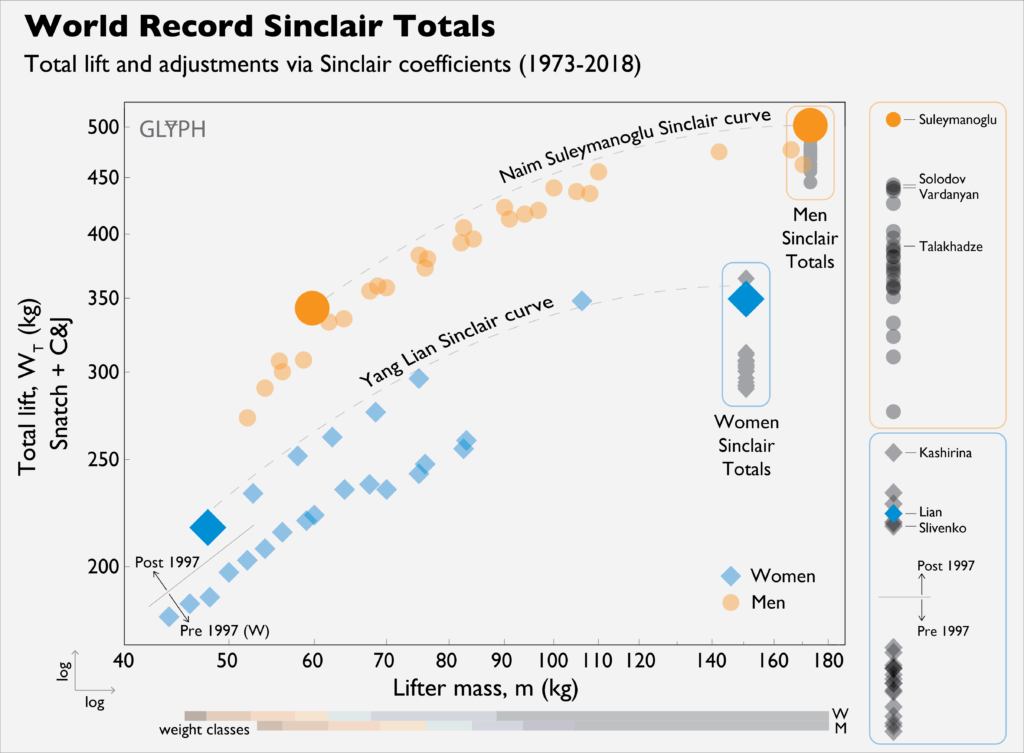
The plot shows world records in all weight classes for the total lift from 1973-2018 as a function of lifter mass. Also plotted (as gray data markers) are the Sinclair totals corresponding to each of these records, which now cluster together and allow for comparison. In the men’s class, the large orange circles mark the unmodified and Sinclair totals for Naim Süleymanoğlu, who has the largest Sinclair total of all time at 501.5 kg, performed at the 1988 Olympics. It’s really not close either; the second highest Sinclair total belongs to Victor Solodov at ![]() 488.9 kg. This means that Süleymanoğlu would out lift Solodov by 13 kg if each weighed
488.9 kg. This means that Süleymanoğlu would out lift Solodov by 13 kg if each weighed ![]() 173.8 kg. On the women’s side, we’ve highlighted the world record of Yang Lian (large blue diamonds). She posted a Sinclair total of 349.3 kg in 2006, good for the fourth highest women’s Sinclair total of all time, and trailing only three athletes who were caught using steroids in their careers.2 The highest women’s Sinclair total is 364.4 kg by Tatiana Kashirina, who was suspended for two years in 2008.
173.8 kg. On the women’s side, we’ve highlighted the world record of Yang Lian (large blue diamonds). She posted a Sinclair total of 349.3 kg in 2006, good for the fourth highest women’s Sinclair total of all time, and trailing only three athletes who were caught using steroids in their careers.2 The highest women’s Sinclair total is 364.4 kg by Tatiana Kashirina, who was suspended for two years in 2008.
A brief history of weight. In order to compute our second GOAT metric – the largest world record increase within each weight class – we’d ideally like the entire history of such records. For men, these data exist with excellent fidelity. Record keeping for women, however, seems to be much less granular; please, we encourage you to lobby the IWF to this end. What we do know for women are the records as of each year in which weight classes were modified: 1992, 1997 and 2018. Calculating percent increase in the world records (Sinclair adjusted), we find the following top performances (again excluding dopers): Yang Lian (13.2% increase set in 2006, Flyweight class), Hsu Shu-ching (13.9% increase set in 2014, Featherweight class) and Oksana Slivenko (18.4% increase set in 2007, Light Heavyweight class). These jumps post-1997 are quite large, and are in fact reflected across all women’s weight classes (see above figure). One hypothesis to explain such dramatic increases is that the sport of women’s weightlifting is relatively young. It only entered the Olympics in 2000, which presumably drove up the competition and recruitment in subsequent years.
On the men’s side, we decided to look at world records as of the end of each year from 1962-2018. And now you too can look at them:
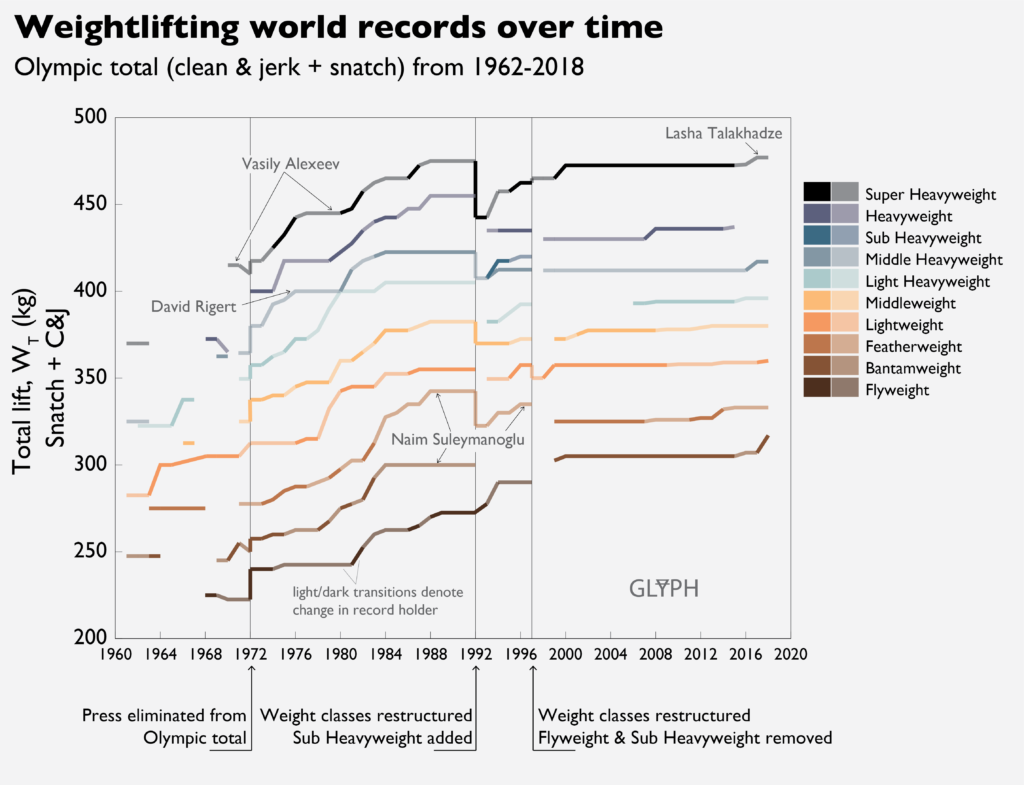
Harkening to the dramatic growth in women’s records over the last 20 years, men’s records exploded from 1972 to 1992. Although men’s weightlifting has been in the Olympics since 1920,3 one could argue that it was actually a young sport starting in 1973. Following the 1972 Olympics, the clean & strict press, a shoulder strength intensive movement, was removed from the Olympic style competition. Lifters were free to dedicate more muscle mass to lower body and other muscles more critical for the clean & jerk and snatch. Considering our first article on weightlifting that showed the relationship between muscle mass and total weight lifted, one might therefore expect the sport to have undergone a significant evolution following 1972, as is observed in the historical record.
In terms of who made the biggest leaps in records, several are pointed out on the figure. David Rigert is interesting because he was a record holder before 1973, when clean & strict press was still in. The clean & jerk + snatch portion of his 1972 record was 364.5 kg, which he increased by 11.5% to 400 kg by 1980. Vasily Alexeev also spanned the 1973 rule change and saw similar improvements in his numbers in the late 70’s, when it is also rumored that he was eating Flyweight lifters for extra protein.4 But again, the most impressive male lifter is Naim Süleymanoğlu, who not only increased the world record in the Featherweight class by 9.6% from 1984-1992, he also held the record in the Bantamweight class AT THE SAME TIME!
The Pocket Hercules and Keyser Söze. The evidence for male (billy?) GOAT is pretty clear: it’s Süleymanoğlu. Nicknamed The Pocket Hercules, he stood only 4 ft 10 in. tall, weighed 132 pounds and was quantitatively the strongest pound-for-pound lifter of all time. He also has quite an interesting personal story. Born in Bulgaria to Turkish parents, he missed the 1984 Olympics because the Eastern Bloc boycotted them. Then, in the prime of his career he defected to Turkey, who paid $1 million to the Bulgarian government to release him to compete at the 1988 Olympics. By the end of his career, Süleymanoğlu had won three Olympic gold medals. He also clean & jerked 3.16 times his bodyweight and remains the only lifter to ever snatch 2.5 times their bodyweight.
The women’s field is a bit more muddled, but based on the metrics we’ve narrowed the selection to two: Yang Lian of China and Oksana Slivenko of Russia. Slivenko’s record made a larger percent increase in her respective weight class than did Lian’s (18.4% vs. 13.2%), but she has a smaller Sinclair total (344 kg vs. 348 kg for Lian). Valid arguments can be made for both. However, we’re sort of intrigued by the fact that the 5 ft 0 in. Yang Lian is an enigma. She had a few results at regional competitions in 2005, then showed up at the 2006 weightlifting World Championships and threw down the monster world record still standing today. A couple of footnote performances in 2009, and like that… poof… she’s gone. Apparently only showing up again as the subject of a physics textbook question, which is also quite endearing.
So there you have it. In this sport of titans, both of our GOATs are atomic.
World records sourced from chidlovski.net and iwf.net for men, and iwf.net and wikipedia.org for women.
- Sinclair, R. G. “Normalizing the performances of athletes in Olympic weightlifting.” Canadian journal of applied sport sciences. 10.2 (1985): 94-98.
- We’re not necessarily excluding athletes based on steroid allegations, but these cases seem fairly clear.
- Men’s weightlifting has actually been in the Olympics since 1896, but first appeared in it’s recognizable form in 1920. Men lifting weight of course goes back further than the modern Olympics. The evolutionary pressures that lead men to lift weights are believed to stem from the selective advantages of Pec Bouncing in attracting mates. Please don’t fact check that last bit. It’s not true.
- unsubstantiated

